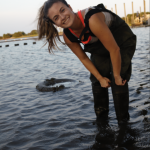
Jordan Gossett
Zoology Ph.D. Student
E-mail: jgossett @ hawaii.edu
Education
2016 M.S. Marine Biology, University of North Carolina Wilmington
2013 B.S. Marine Biology, University of North Carolina Wilmington
Interests
Genome evolution, insect endosymbiosis, population genetics, speciation
Research
Cave-adapted planthoppers
As the youngest island in the Hawaiian archipelago, Hawaiʻi Island was formed by the dynamic geological processes of five volcanoes at different geological time points which has consistently formed new landscapes and ecosystems over the last 0.5 million years (MY). Lava flows harden to form a network of lava tube caves that span the island and serve as habitat for many endemic arthropod species. Cave-adapted fauna that inhabit lava tube caves of different geological ages can serve as natural replicates through which to study genetic variation in a phylogeographic framework. My research focuses on testing hypotheses regarding gene flow and population divergence of cave-adapted planthoppers residing within the lava tube cave network to understand the diversification of populations across various geological and temporal gradients.
Symbiosis
Hawaiian planthoppers of the genus Oliarus harbor three obligate endosymbionts, “Candidatus Sulcia muelleri”, and “Ca. Vidania fulgoroidea” that provision essential nutrients missing from their sap diets. Oliarusplanthoppers on Hawaiʻi Island occupy diverse habitats such as lava tube caves and surface foliage, each with different nutritional resources and environmental constraints. I am using a combination of comparative genomics approaches and selection analyses, to test hypotheses regarding the relationship between environmental selection on obligate host-symbiont alliances and genomic variation in endosymbionts.
Hawaiian planthoppers of the genus Oliarus harbor three obligate endosymbionts, “Candidatus Sulcia muelleri”, and “Ca. Vidania fulgoroidea” that provision essential nutrients missing from their sap diets. Oliarus planthoppers on Hawaiʻi Island occupy diverse habitats such as lava tube caves and surface foliage, each with different nutritional resources and environmental constraints. I am using a combination of comparative genomics approaches and selection analyses, to test hypotheses regarding the relationship between environmental selection on obligate host-symbiont alliances and genomic variation in endosymbionts.
Publications
2022. J.M. Gossett, M.L. Porter, Y. Vasquez, G.M. Bennett, R.A. Chong. Genomic comparisons reveal selection pressure and functional variation between nutritional endosymbionts of cave-adapted and epigean Hawaiian planthoppers. (In Revision)